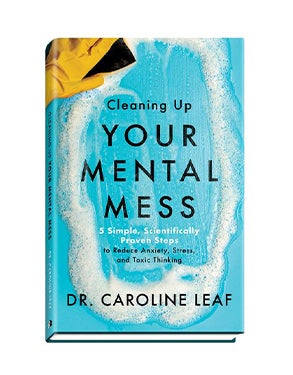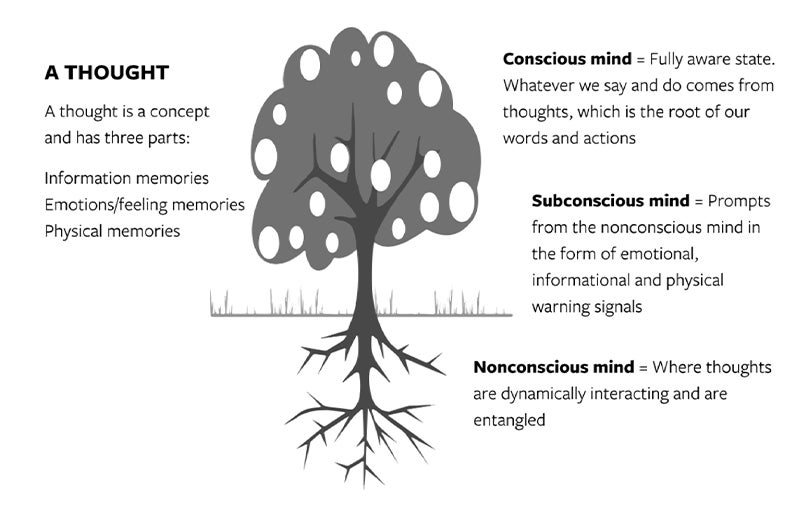
Her book, “Cleaning Up Your Mental Mess,” takes readers through a 5-step process to manage runaway thoughts, detox trauma, and build a healthy and resilient brain that responds to all kinds of adversity in healthy ways. The process she calls “neurocycling” is based on the science of directed neuroplasticity to unwire toxic habits and trauma, and can help reduce anxiety and depression by up to 81%, according to clinical studies and clinical application conducted in her research over three decades.
Mindfulness is not enough, according to Dr. Leaf. We must learn to go beyond mindfulness to manage the mess in our minds, just like we learn to manage our external environments. She even encourages us to accept that it’s ok to feel messy. Life is messy. The key is learning to manage the mess better—and we can all do this.
“You are your mind. You are always using your mind; your mind is always with you. We can go three weeks without food, three days without water, three minutes without oxygen—but we can’t even go for three seconds without thinking,” says Dr. Leaf. “We don’t need more diagnostics, we need mind management.”
Brain science can help in the transition from being aware of toxic thoughts to catching them and managing them early on, as well as detoxing trauma thoughts that disrupt our lives.
Dr. Leaf offers hope that these thoughts can be a crossroads offering other paths to a healthier, happier experience. When you’re driving down a road and see signs, you follow them. We take care to learn what those signals mean and how to manage them as we drive so that we can get where we are going safely and successfully.
Emotions like anxiety, depression and panic are not labels, but rather warning signals, and Dr. Leaf says these discomfort zones are the physical, emotional, and informational caution signs from physical, emotional, and informational memories in a thought. “These warning signals are invitations to look inward, which is important to do because they disrupt the balance in the mind, brain, and body. If you can’t sit with them and listen to them, you run the risk of losing the opportunity to gain priceless information that will help you with your healing,” says Leaf. “Not only can we rewire our brain, but we can regenerate it as well.”
Feeling emotions can feel messy, and Dr. Leaf says that’s ok. “We live in a society that doesn’t give us permission to be messy. We need to accept it as a totally normal part of being human. There’s meaning behind sadness. The mess is part of what we need so we can grow and repair.”
The mind is an amazing powerhouse. It is different from the brain, which is the physical part of the mind. Dr. Leaf explains that the mind directs the brain; every choice you make with your mind creates actual cells that are influenced and built by the brain.
In three decades of study, Dr. Leaf has discovered that we can direct our brain for change by learning to tap into self-awareness and self-regulation that allows us to develop a sense of peaceful control and mental space necessary for coping and overcoming.
The mind is made up of trillions of thoughts. A thought is a real physical thing that occupies space in the brain and mind. A thought is built into the brain as you use your mind—as you think, feel and choose.

Thoughts look like trees. A thought is a big idea—the tree. And a thought is made of memories, like branches and roots of a tree. There are 3 types of memories: informational, emotional and physical. What and how you think about something grows, just like watering a tree.
You can create a healthy tree or an unhealthy tree. Thinking, feeling, and choosing are shaping, pruning and building—which is the mind in action. The more self-regulated you are, the more effective this process is and the more peace and meaning you will find in life.
Discovering what your body goes through as you think, feel, and choose is helpful to understand how it is possible to manage your mind and clean up your mental “mess.”
Thoughts are in 3 places: your brain, your mind, and your cells.
- The brain – Thoughts with embedded memories are stored physically in the brain as energy vibration in protein supercomputers, called tubulin, in the dendrites on your neurons. As we think, feel, and choose, we grow more dendrites into the brain for new memories. The energy vibrations are how brain scientists study the activity in the brain in an EEG or qEEG technology (delta waves, etc.).
- The mind – Thoughts are also stored in the nonconscious mind as an energy field. This is the deep, spiritual level of a thought that goes beyond the physical but is connected to it. It’s your unique perception and way of experiencing the world.
- The cells – Thoughts are also stored in the cells of the body, “cellular memory.” Epigenetics is the science of understanding gene activity and structure, how thoughts and environment can switch them on and off. An example of this is learning to play an instrument changes the way a gene acts in the brain. Dr. Leaf explains this science in more detail in Chapter 6 of her book.
The ability to build new pathways in the brain is called “neuroplasticity.” The process takes time and effort. The Neurocycling process explained in “Cleaning Up Your Mental Mess” addresses two levels of mind management:
- Trauma of varying degrees
- Toxic thinking habits
“You are not going to rewire the brain or change it physically unless you go through the correct time. It’s just like when your body gets a blister; it takes time to go through the healing process.” “The idea is to allocate time in your day where you are consistently working on the most major issue that’s messing with you. Identify the pattern, what you are ruminating on the most, what is your most intrusive thought, what is stopping your creativity or functioning at the level you want to be.” The process is simple, but it’s the little, directed and organized daily changes that cumulatively make the biggest difference.
THIS IS DONE IN CYCLES OF 63 DAYS
- It takes 21 days to build a long-term thought with its embedded memories.
- It takes ANOTHER 42 days to turn a thought into a habit.
Benchmark Days – Those who have practiced Neurocycling feel change happening at specific time points along the way (day 7, 14, 21, 42 and 63), which can motivate through the entire 63-day cycle of detoxing or building a thought.
Dr. Leaf recommends starting with the 63-day cycle, giving yourself 15 to 45 minutes each day. Bring up lots of information and see what bubbles up until it becomes a routine. Remember, you’re developing a habit. It’s not a “fix it now” process. You are changing your mindset.

Neurocycling is part of her own daily practice. “I’m human. I still have things from my past affecting me now, and affecting my future. Neurocycling is a system I can use to manage my mind when my mind never stops. If I don�’t do the 63 days and I don’t manage my mess, then I’m a worse mess. In 63 days time, I can get it under control.”
Mind management is more than meditation. Because our brains are designed to process information to act, getting stuck in the awareness stage can also be harmful. “If you’re in a bad state, you could get stuck and meditate too much on what’s going wrong,” explains Dr. Leaf.
Meditation is essential but it is not actively making a change in your brain. Meditation helps settle the brain and neurophysiology down. The object of meditation is to calm down and unwind from activity and this prep work helps your brain be in a more calm and prepared state for doing the actual work of the five steps. A sauna is a fantastic place to decompress, and Dr. Leaf offers 21 different brain preparation activities that can be done during a sauna session to prepare for Neurocycling.
Like exercise and eating right for your body, “Clean Up Your Mental Mess” empowers you to incorporate mind management as part of a healthy lifestyle. There are several ways to learn more about Neurocycling:
- Purchase the book, “Cleaning Up Your Mental Mess” here.
- Download the accompanying Neurocycle app – it’s free!
- Watch Connie Zack’s conversation about Neurocycling with Dr. Caroline Leaf on Facebook here.
Information taken from “Cleaning Up Your Mental Mess,” by Dr. Caroline Leaf, published March 2021, and interviews with Dr. Leaf in September 2021.



